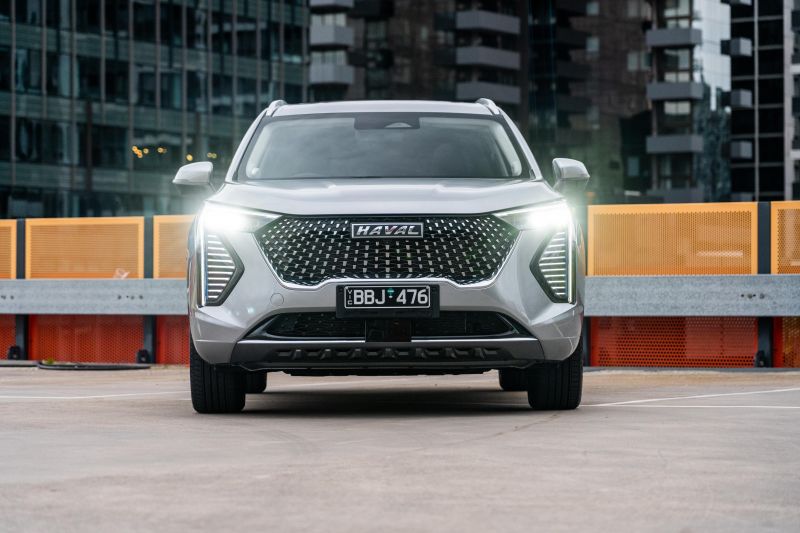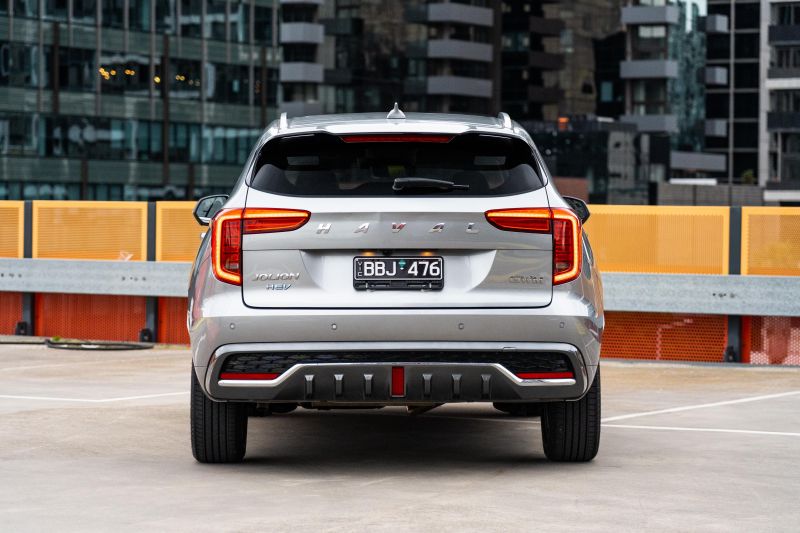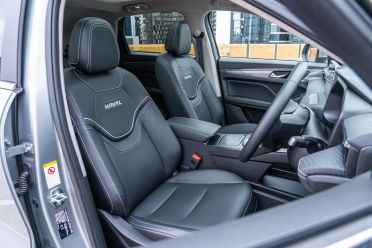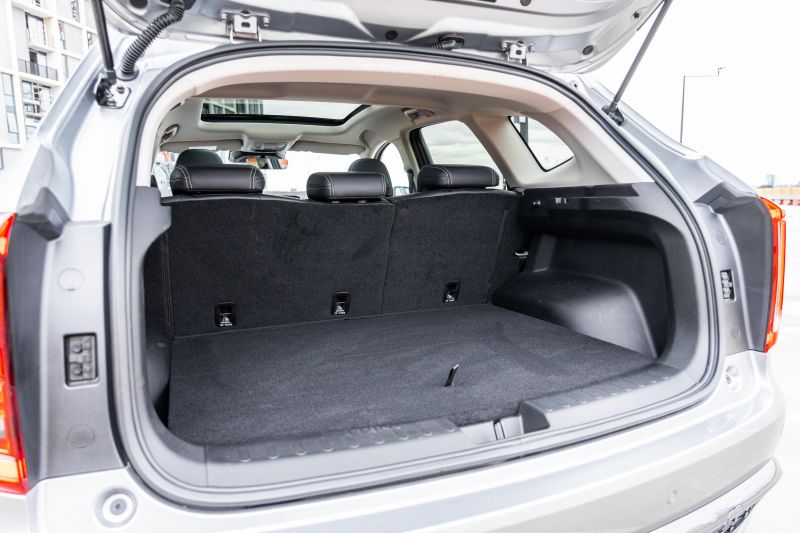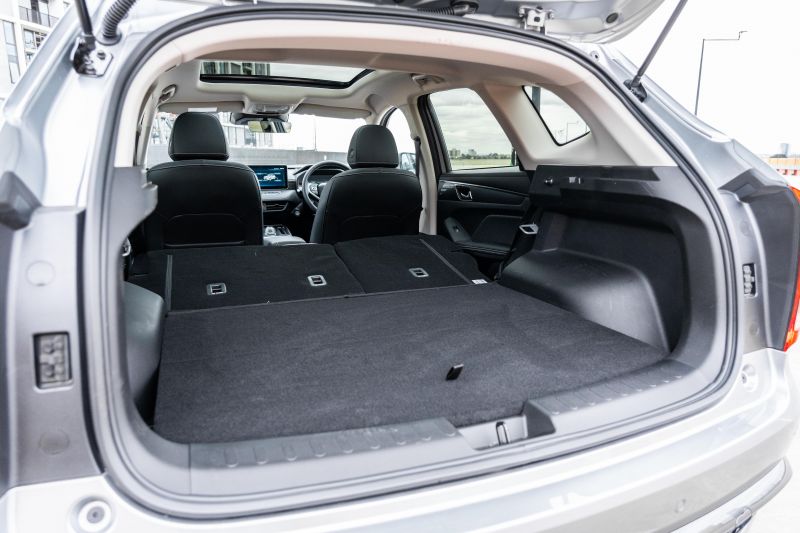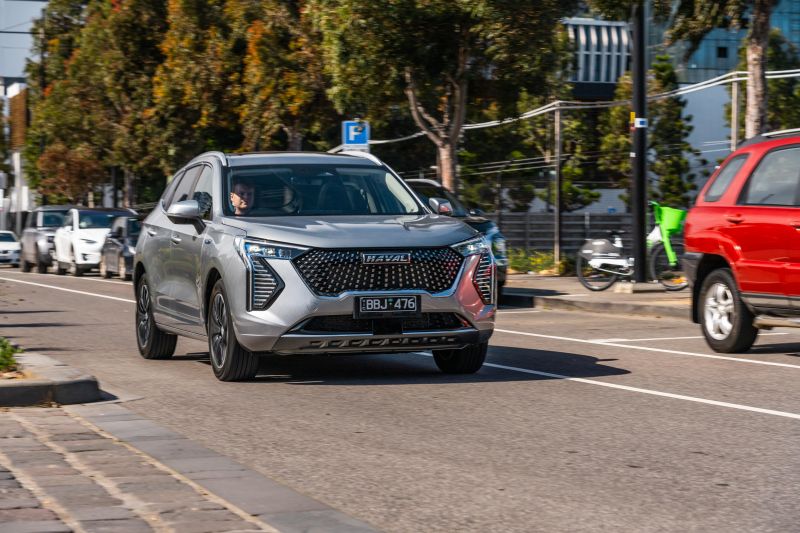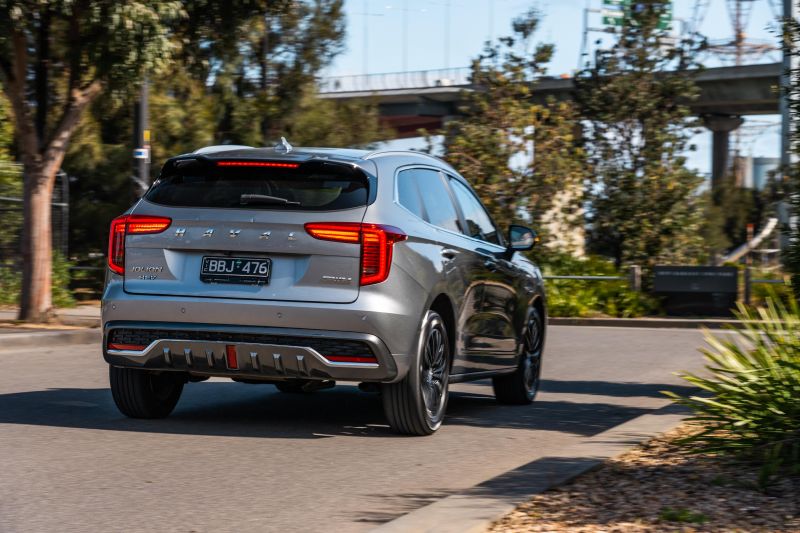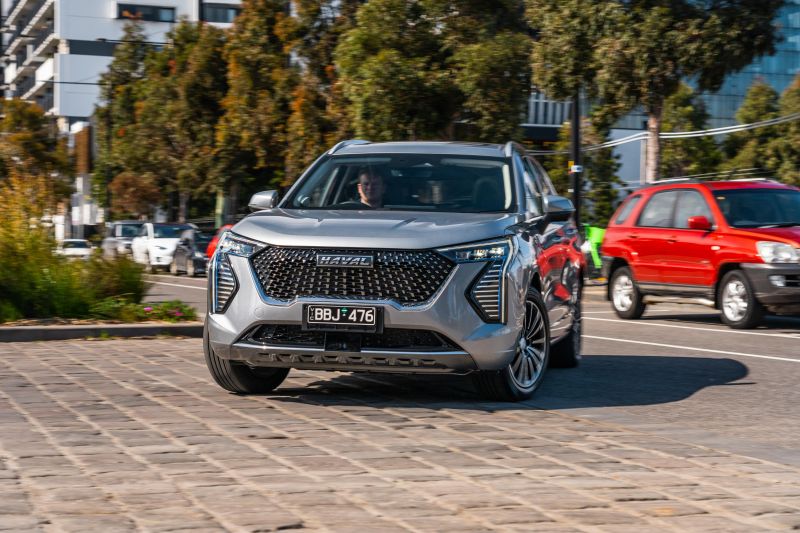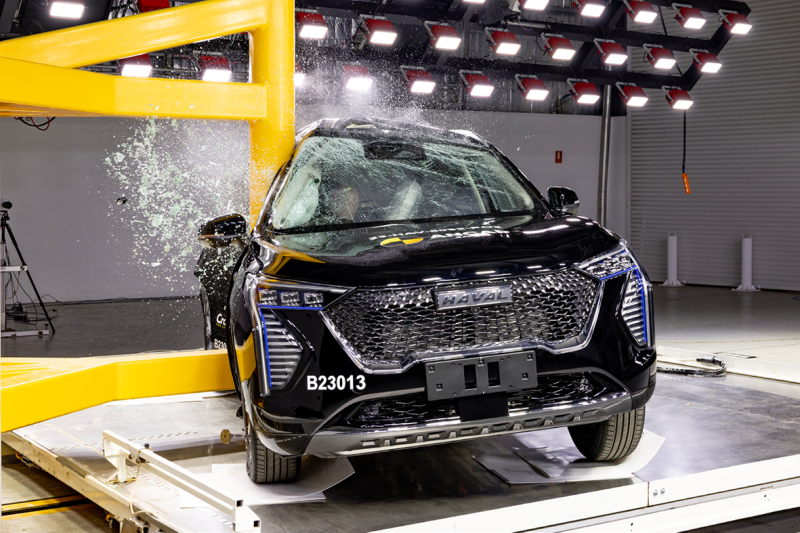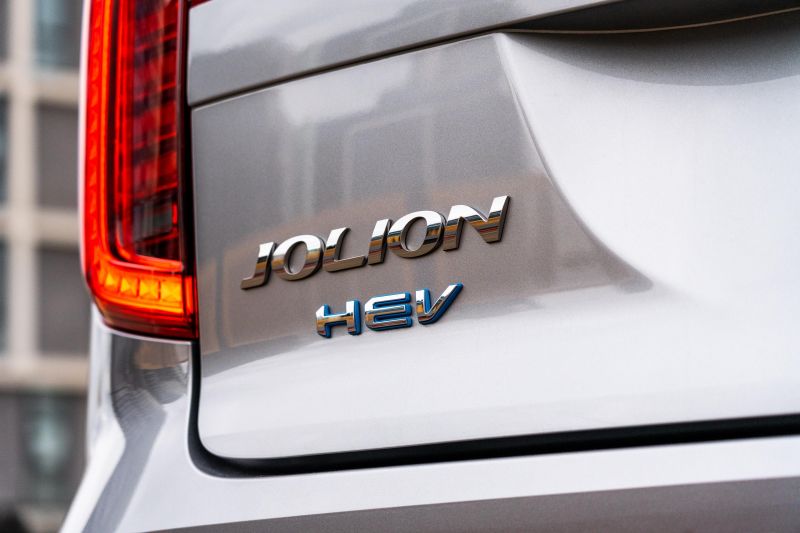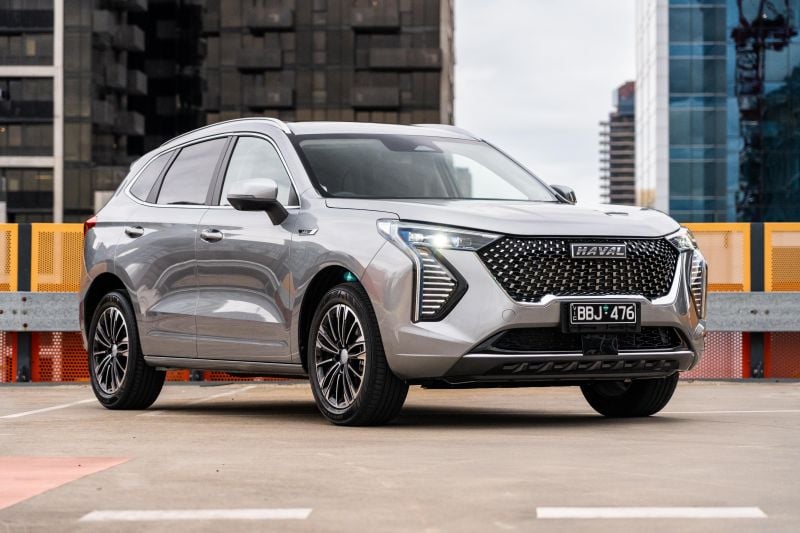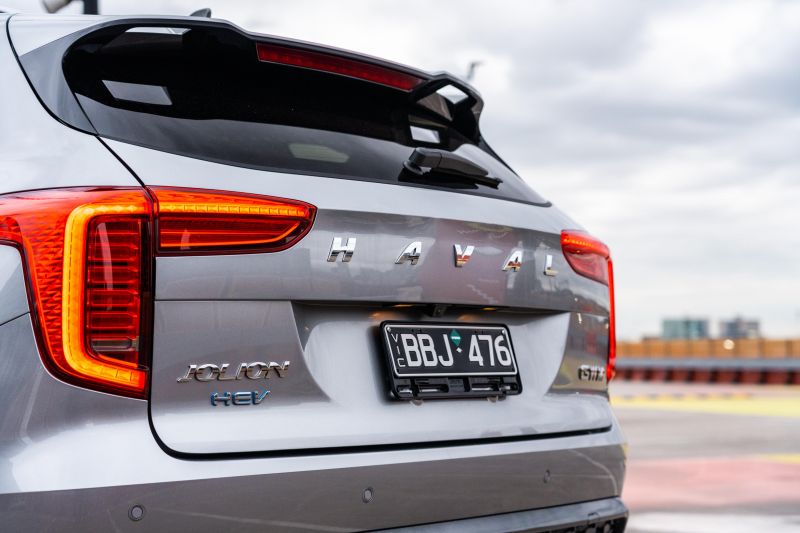GWM Haval has made a sharp ascent up the sales charts over the past two years, undercutting ‘name brand’ rivals with much improved products in high-growth segments like SUVs and utes.
The GWM Haval Jolion is no exception. GWM has sold more than 7000 this year, greater volume than the Hyundai Kona, Kia Seltos, Toyota Corolla Cross or Nissan Qashqai have managed – though some way off the now top-selling MG ZS, a fellow budget-friendly Chinese entrant.
Given economic headwinds like inflation and interest rates keep taking bites out of household spending power, GWM’s keen drive-away prices and long warranty position it to capitalise and continue gaining market share.
The version of Jolion driven here isn’t the price-leader, but rather taps into strong demand for electrified hybrids, which remain in short supply due to ongoing production issues for dominant player Toyota – meaning even second-hand ones are extra expensive right now.
In fact, GWM Haval is reporting significant hybrid take-up across its SUV range, sitting at around 40 per cent of the total.
If you’ve spotted a heap of these getting about on roads near you and wondered if they’re any good, then read on…
How does the Haval Jolion fare vs its competitors?
View a detailed breakdown of the Haval Jolion against similarly sized vehicles.
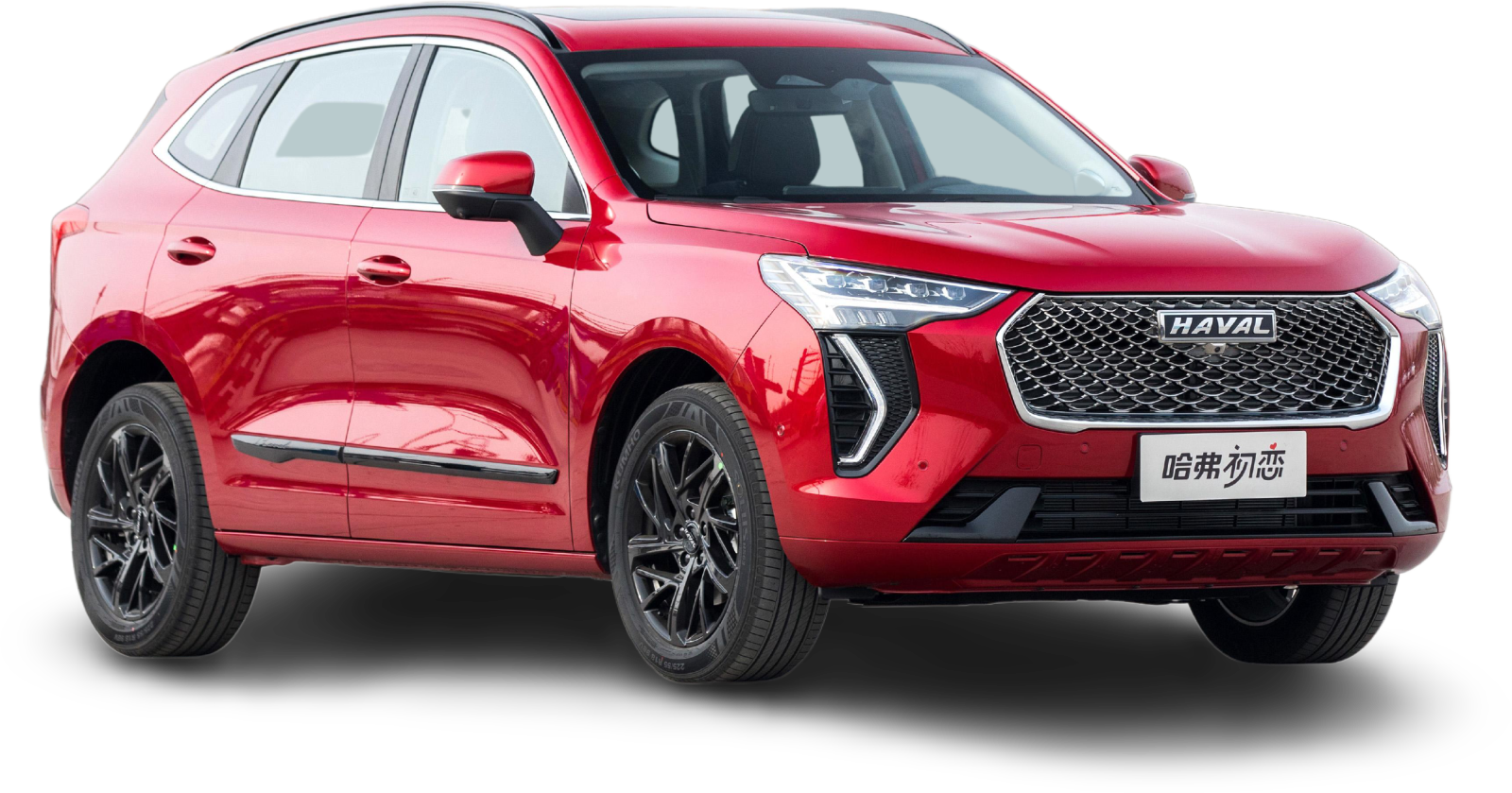
Haval
Jolion
How much does the Haval Jolion Ultra Hybrid cost?
The wider Jolion range kicks off at a very sharp $26,990 drive-away and tops out at $39,990 drive-away nationally for the version tested here, according to the GWM website at the time of writing.
There are four specification grades on offer across two engine types, with the hybrid commanding a premium of between $4500 and $6500 over the equivalent petrol version.
Looking at the hybrid range priced between $35,990 and $39,990; they stack up on the dollars and cents against core competitors. In short, a top-of-the-range Haval Jolion Ultra Hybrid undercuts the starting price of most competitors, while the entry variant is thousands cheaper.
Key rivals include:
- Hyundai Kona Hybrid: ~ $40,000 to $49,500
- Subaru Crosstrek Hybrid: ~ $43,700 to $50,500
- Kia Niro Hybrid: ~ $49,900 to $55,750
- Toyota Corolla Cross Hybrid: ~ $41,000 to $55,000
- Toyota Yaris Cross Hybrid: ~ $34,800 to $44,200
Prices are drive-away based on a Melbourne postcode (3000)
2024 GWM Haval Jolion pricing:
- Jolion Premium Petrol: $26,990
- Jolion Lux Petrol: $30,490
- Jolion Ultra Petrol: $33,490
- Jolion S Petrol: $35,990
- Jolion Lux Hybrid: $35,990
- Jolion Ultra Hybrid: $39,990
Prices are drive-away
What is the Haval Jolion Ultra Hybrid like on the inside?
The Jolion Ultra Hybrid has a proximity-sensing key that lets you access the vehicle with the fob in your pocket, and power-adjustable faux leather seats that in truth could use a little more under-thigh support.
The interior looks sharp on first impression, with a tastefully minimalist layout, coloured LED lights, large landscape-oriented touchscreen, tastefully thin-rimmed wheel, and nifty shift-by-wire transmission dial. The panoramic sunroof and little luxuries like heated seats add to the overall experience too.
From a showroom ‘wow’ perspective, it’s going to keep scooping up converts. It looks a heck of a lot more modern and interesting than a base Toyota.
It is built to a price though, as you might expect. There’s some nice padded material on parts of the dash and doors, but some of the trims used on the centre tunnel, doors, wheel, and upper dash don’t feel quite as expensive and ‘premium’ as they look on first impression. It’s no Mazda, let’s just say that.
Note: Our test vehicle was more than a year old and had more than 10,000km on it, which isn’t much for a regular car but more than is typical for a press evaluation car.
Despite its hard life (press cars do not get special treatment between loans these days, this car was peppered with dents), there were no squeaks or rattles or misaligned panels.
The steering wheel only adjusts up and down, with the lack of telescoping a potential issue for those with unusual proportions. Behind the wheel sits a digital display with various display modes, augmented by a nice head-up display (HUD) projecting the vehicle speed onto the windscreen.
However – another ergonomic gripe – I couldn’t get the HUD to drop down low enough to be fully visible. At 194cm I’m taller than average, but not so much of an outlier than my driving position shouldn’t be catered for.
The big centre touchscreen looks great and has a swish surround-view camera display, and processes inputs pretty well.
Satellite navigation isn’t an option, but wired (USB-A) Apple CarPlay and Android Auto mean you can still access Google Maps on the move.
While there are some buttons below the screen to adjust topline climate control functions, many of the functions are in a sub-menu.
In fact, there’s a fair bit of tapping and swiping to be done if you want to access information or media while on the move, meaning the UX software could made a little more user-friendly – something as simple as a better fixed shortcut toolbar menu running along the bottom of the screen would do it.
There are plenty of storage spaces around the cabin, from the charging slot beneath the transmission tunnel to the bottle-friendly door bins and decent-sized console, to the hidden section below the tunnel freed up by the transmission’s rotary dial shifter
By the way, said e-shifter does not ‘stop’ once you’ve put the car into Reverse and Drive, but rather keeps spinning, so you need to see which letter is illuminated to know what gear you’re in.
One area where the Jolion inarguably shines is back-seat space. I had headroom and legroom to spare – behind my driving position, and factoring in the space-stealing sunroof – meaning this is a very capable family vehicle.
Rear occupants get niceties such as as vents, USB ports, cupholders, and LED lights, while the floor is flat in the back, so the middle passenger doesn’t need to awkwardly straddle a hump. Some small SUVs aren’t all that practical, but the Jolion certainly is.
The boot? Behind the manual tailgate is a shallow boot floor and a cargo area with 390 litres of storage, down 40L over the petrol.
The hybrid also loses the petrol’s space-saver spare tyre in favour of a less-useful puncture repair kit.
What’s under the bonnet?
The Jolion Hybrid pairs a 1.5-litre petrol engine, with an electric drive motor and battery, producing system outputs of 139kW of power and 375Nm of torque driven through the front wheels.
Fuel consumption on the combined-cycle test is 5.0 litres per 100km, and it will run on 91 RON petrol. While not as efficient as the Kona HEV (3.9L/100km) or Corolla Cross Hybrid (4.3L/100km), it’s 60 per cent better than the Jolion petrol (8.1L/100km). The 55L tank promises a range of 1000km.
While it’s not the most efficient hybrid, it’s not short on punch, with 34 per cent more power and 42 per cent more torque than the Hyundai Kona Hybrid’s setup. Meanwhile petrol-only Jolion’s turbocharged engine makes only 110kW and 220Nm.
The 0-100km/h time is a brisk (for this segment) 8.2 seconds if you really punch it. The Jolion Hybrid’s transmission has two forward speeds called D1 and D2, the latter for more responsive pickup from the petrol engine. The battery pack powering the motor-generator is sourced from CATL and is recharged by kinetic energy.
Haval quotes a braked towing capacity of 1300kg, or 200kg less than the petrol model.
How does the Haval Jolion Ultra Hybrid drive?
We really didn’t get along with the petrol-only Jolion’s tendency to be unpredictable and laggy at low speeds, as you can read in our separate review here – but to my senses the hybrid is smoother.
The Jolion’s system works in the same way as most hybrids. At idle, reverse and low speeds under 35km/h the electric motor does most of the work, then assists the engine at higher speeds.
Hybrids tend to be great for city traffic because of the electric propulsion in stop/start driving, and the Jolion is no different. The electric motor usually moved the car off the mark and generally accelerated the vehicle to 30km/h, so when the ICE fired up the car’s momentum had smoothed it out.
However, there were a couple of occasions where the vehicle’s petrol engine fired up at idle, presumably because the brake regen system hadn’t topped up the battery enough. You won’t find a Toyota doing that.
Unlike the bigger Haval H6 Hybrid and its 530Nm turbocharged drivetrain, the 375Nm Jolion isn’t predisposed to chirping its tyres when you bury the throttle off the mark. It still packs a decent punch, but it’s more well-mannered here.
At higher speeds the petrol engine kicks in, but is rarely raucous, credit to the transmission there. Generally the two means of propulsion work well together. The e-motor can also power the vehicle while coasting or slowing, allowing the engine to disconnect and save fuel.
While GWM claims efficiency of 5.0L/100km, my drive routes yielded averages of between 5.7L/100km and 6.1L/100km. The petrol-only model remains the value play given it’s $6500 cheaper, and that buys a lot of fuel, but the hybrid also offers better performance despite being 100kg heavier (1530kg).
Ride quality and handling is actually quite decent. Sometimes these new Chinese brands make zero effort when it comes to suspension tune, but the Jolion offers a degree of cornering agility and ride comfort – one slight gripe being that its body control after undulations could be kept a little tauter.
While the list of driver assist aids ticks all the boxes, the touchscreen-heavy user interface can frustrate at times, and the systems themselves can become intrusive.
For instance the active steering assist worked well, however the lane-centring function was too intrusive when engaged, making too many micro-adjustments. Thankfully you can keep this function off while retaining all the other lane-keeping aids, and when it’s turned off it stays that way upon restart.
With active cruise control and lane-keeping aids on, the driver instrument cluster also defaults to a digital diagram of the systems at work. It’s great until you realise it overrides your trip meter, meaning you need to hold a button on the wheel to view your fuel economy etc while driving – small irritants.
More invasive is Intelligent Cornering, which uses the cameras to scan the road. With adaptive cruise control on it will automatically reduce the car’s speed ahead of curves, but it’s too conservative and slows down more than necessary, requiring accelerator prods to override.
These aren’t criticisms of the technology here as a whole, just of the lack of refinement in regards to the way it’s been calibrated and put into the user interface. These features should work with the driver behind the scenes, only becoming obvious when needed.
What do you get?
Jolion Ultra highlights:
- 18-inch wheels
- LED headlights
- Proximity-sensing key
- Privacy glass
- Auto-folding side mirrors
- Automatic wipers
- Roof rails
- Panoramic glass sunroof
- Tyre pressure monitor
- Auto-dimming rear mirror
- Wireless phone charger
- Synthetic leather seat trim
- Powered driver’s seat
- Heated front seats
- Dual zone climate control
- 7.0-inch instrument cluster
- Head-up display
- 12.3-inch touchscreen
- Front and rear USB ports
- 6-speaker audio
- Apple CarPlay, Android Auto
- 360-degree cameras
If you want to save $4000 and buy the Haval Jolion Lux Hybrid instead, you lose:
- 18-inch wheels (17-inch instead)
- Wireless phone charger
- 12.3-inch touchscreen (10.25-inch instead)
- Head-up display
- Sunroof
Colour choices include Hamilton White (free) or Azure Blue, Glacier Blue, Smoke Grey, Golden Black, or Mars Red (all $495 extra).
Is the Haval Jolion Ultra Hybrid safe?
In short, yes – the Jolion range wears a five-star ANCAP safety rating based on 2022 testing.
It managed 90 per cent for adult occupant protection, 84 per cent for child occupant protection, 64 per cent for vulnerable road user protection, and 92 per cent for safety assist features.
Standard safety features include:
- Airbags: Front, front side/centre, two-row curtain
- 2 x ISOFIX and 3 x top tethers
- Autonomous Emergency Braking (AEB)
- Vehicle, Pedestrian, Cyclist detection
- Crossings, Junction assist
- Adaptive cruise control with stop/go
- Blind-spot monitoring
- Lane centring assist
- Lane keep assist incl. emergency assist
- Rear cross-traffic assist
- Traffic sign recognition camera
- Speed limit assist, speed warning
- Door open warning
- Driver drowsiness detection (camera)
How much does the Haval Jolion Ultra Hybrid cost to run?
GWM provides a seven-year, unlimited kilometre warranty and five years capped-price servicing at 12 month or 15,000km intervals – aside from the first service, due at 10,000km – at an average of $330 per visit.
The company also provides five years of 24/7 roadside assist cover.
CarExpert’s Take
Like a number of new-to-market Chinese cars, there’s still room for a bit more refinement.
Key areas for improvement include the infotainment user experience, driver-assist system calibration, and cabin ergonomics. Plus, the hybrid’s price premium over the equivalent petrol is too high.
However, it still impresses when it comes to sheer value-for-money, interior space and the balance of performance and fuel efficiency. Plus offering a long warranty is a smart way for a less well-known brand to fast-track its reputation, breaking down one barrier to ownership and bolstering the eventual resale value at the same time.
There are now fewer and fewer reasons not to consider a challenger brand like GWM. I’m a conservative buyer and would gravitate to a less flashy and less-well-equipped base Toyota or Hyundai, but I can definitely see things from a Haval Jolion owner’s perspective – and there are thousands of those out there already.
Click the images for the full gallery
BUY: GWM Haval Jolion
MORE: Everything GWM Haval Jolion

